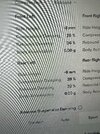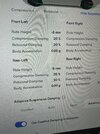….. an update on what I’ve been doing. Since Tesla apparently isn’t interested in hearing from their customers, it occurred to me that they might listen to a suspension expert. After a little asking around in the suspension industry, I learned that Tesla’s air spring/struts are made by Bilstein of America Inc. I messaged them and received an email from technical support person in their aftermarket support group. He said that Bilstein makes the struts to a proprietary Tesla design and that he couldn’t tell me anything about them. So, using the email address, I summarized the situation and said “don’t tell ME anything… tell Tesla“. I suggested that there must be someone at Bilstein with a communication link to Tesla’s suspension group.… and would he please forward this information to them? A few days later, I contacted him again and he said he had sent my email to their head of Product Quality. I asked, but he wouldn’t give me a name or email address. So, we can only hope that this person takes the initiative to follow through on this. I said that Tesla seems to be blissfully unaware that there is even a problem, even though I believe that it affects every Tesla built with Bilstein shocks. I suggested that an “intervention“ is in order as fixing the problem is in everyone’s best interests… Tesla, Bilstein, and the customer‘s.
The summary of the situation I included, I think, presents a clear picture of the facts that resulted from my research. Here it is:
- the damping rate is controlled by proportional, normally closed, solenoid valves
- these valves are opened by increasing the duty cycle of a 16 volt, 1 Khz, Pulse Width Modulated voltage
- the duty cycle of the control voltages is displayed on the “show suspension data” screen… ERRONEOUSLY LABELED as “Percentage Damping”!
- there are 7 driver selected Ride Comfort settings: Comfort, Sport, and (under “Advanced”) the 5 position Ride Comfort slider, Soft to Firm
- each of these settings should establish a basic control voltage duty cycle (bias) appropriate to the level of ride comfort called for. THIS IS THE PROBLEM! only 2 of the 7 settings (Sport and the firmest slider) loads a reasonable duty cycle! The other 5 leave the duty cycle at 0%, or close to it, resulting in the harshest ride possible
- the basic bias duty cycle is added-to as the vehicle encounters rough pavement (this part works fine)
Looking at this, it is clear to me that there is only one step missing from Tesla’s implementation of the Variable Ride Control system… they have neglected to “tune“ the system. If you were to install aftermarket coil-over shocks on your car, the last step would be to “tune“ them by turning the screwdriver-adjustable valves on each one to get the type of ride you are looking for. Tesla shocks are electronically adjustable, but you STILL need to tell them what setting constitutes “soft” vs. what setting means “firm”. It appears that no one has ever done this. Perhaps Tesla’s “flat“ organizational chart is to blame? The engineers designed the hardware, the coders designed the operating software, but NOBODY was responsible for tuning the system! (….. “I thought YOU were doing that”) …and there was no one is responsible for the whole thing to see that it’s missing!






